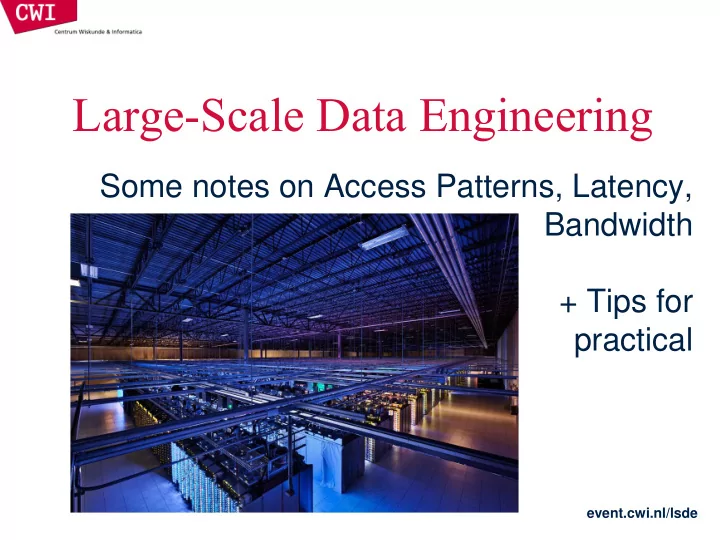

Large-Scale Data Engineering Some notes on Access Patterns, Latency, Bandwidth + Tips for practical event.cwi.nl/lsde
Memory Hierarchy event.cwi.nl/lsde
Hardware Progress Transistors CPU performance event.cwi.nl/lsde
RAM,Disk Improvement Over the Years RAM Magnetic Disk event.cwi.nl/lsde
Latency Lags Bandwidth • Communications of the ACM, 2004 event.cwi.nl/lsde
Geeks on Latency event.cwi.nl/lsde
Sequential Access Hides Latency • Sequential RAM access – CPU prefetching: multiple consecutive cache lines being requested concurrently • Sequential Magnetic Disk Access – Disk head moved once – Data is streamed as the disk spins under the head • Sequential Network Access – Full network packets – Multiple packets in transit concurrently event.cwi.nl/lsde
Consequences For Algorithms • Analyze the main data structures – How big are they? • Are they bigger than RAM? • Are they bigger than CPU cache (a few MB)? – How are they laid out in memory or on disk? • One area, multiple areas? Java Object Data Structure vs memory pages (or cache lines) event.cwi.nl/lsde
Consequences For Algorithms • Analyze your access patterns – Sequential: you’re OK – Random: it better fit in cache! • What is the access granularity? • Is there temporal locality? • Is there spatial locality? location event.cwi.nl/lsde time time
Storage Layout of a Table event.cwi.nl/lsde
Improving Bad Access Patterns • Minimize Random Memory Access – Apply filters first. Less accesses is better. • Denormalize the Schema – Remove joins/lookups, add looked up stuff to the table (but.. makes it bigger) • Trade Random Access For Sequential Access – perform a 100K random key lookups in a large table put 100K keys in a hash table, then scan table and lookup keys in hash table • Try to make the randomly accessed region smaller – Remove unused data from the structure – Apply data compression – Cluster or Partition the data (improve locality) …hard for social graphs • If the random lookups often fail to find a result – Use a Bloom Filter event.cwi.nl/lsde
Assignment 1: Querying a Social Graph event.cwi.nl/lsde
LDBC Data generator • Synthetic dataset available in different scale factors – SF100 for quick testing – SF3000 the real deal • Very complex graph – Power laws (e.g. degree) – Huge Connected Component – Small diameter – Data correlations Chinese have more Chinese names – Structure correlations Chinese have more Chinese friends event.cwi.nl/lsde
CSV file schema • See: http://wikistats.ins.cwi.nl/lsde-data/practical_1 • Counts for sf3000 (total 37GB) Knows(1.3B) PersonFrom Person (9M) PersonTo PersonId PK Tags (16K) FirstName TagID interests(.2B) LastName Name PersonID Gender URL tagID Birthday CreationDate Place(1.4K LocationIP PlaceID PK BrowserUsed URL LocatedIn type event.cwi.nl/lsde
The Query • The marketeers of a social network have been data mining the musical preferences of their users. They have built statistical models which predict given an interest in say artists A2 and A3, that the person would also like A1 (i.e. rules of the form: A2 and A3 A1). Now, they are commercially exploiting this knowledge by selling targeted ads to the management of artists who, in turn, want to sell concert tickets to the public but in the process also want to expand their artists' fanbase. • The ad is a suggestion for people who already are interested in A1 to buy concert tickets of artist A1 (with a discount!) as a birthday present for a friend ("who we know will love it" - the social network says) who lives in the same city, who is not yet interested in A1 yet, but is interested in other artists A2, A3 and A4 that the data mining model predicts to be correlated with A1. event.cwi.nl/lsde
The Query For all persons P : • who have their birthday on or in between D1..D2 • who do not like A1 yet we give a score of – 1 for liking any of the artists A2, A3 and A4 and – 0 if not the final score, the sum, hence is a number between 0 and 3. Further, we look for friends F: – Where P and F who know each other mutually – Where P and F live in the same city and – Where F already likes A1 The answer of the query is a table (score, P, F) with only scores > 0 event.cwi.nl/lsde
Binary files • Created by “loader” program in example github repo • Total size: 6GB Person.bin Knows.bin PersonId PK PersonPos Birthday LocatedIn Knows_first interests.bin Knows_n tagID Interests_first Interests_n event.cwi.nl/lsde
What it looks like 4bytes * 1.3B • Created by “loader” program in example github repo Knows.bin • Total size: 6GB interests.bin knows_first Person.bin knows_n 48bytes * 8.9M 2bytes * 204M event.cwi.nl/lsde
The Naïve Implementation The “cruncher” program Go through the persons P sequentially • counting how many of the artists A2,A3,A4 are liked as the score for those with score>0: – visit all persons F known to P. For each F: • checks on equal location • check whether F already likes A1 • check whether F also knows P if all this succeeds (score,P,F) is added to a result table. event.cwi.nl/lsde
Naïve Query Implementation 4bytes * 1.3B • “cruncher” Knows.bin interests.bin knows_first Person.bin knows_n 48bytes * 8.9M results 2bytes * 204M event.cwi.nl/lsde
Challenges, questions For the “ reorg ” program: • Can we throw way unneeded data? • Can we store the data more efficiently? • Can we put the data in some order to improve access patterns? For the “query” program: • Can we move some of the work to the re-org phase? • Can we improve the access pattern? – we trade random access for sequential access? • Multiple passes, instead of one? We will meet on the leaderboard! event.cwi.nl/lsde
Recommend
More recommend